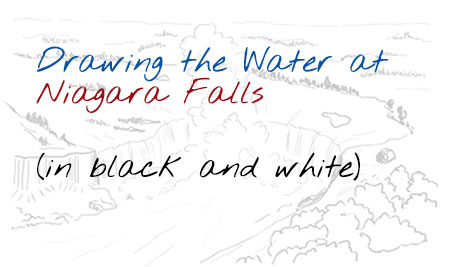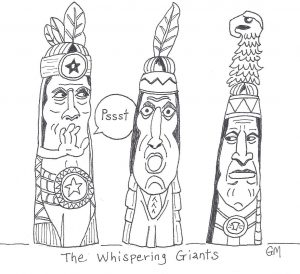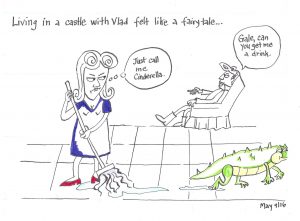Here is the line art challenge that was thrown down last week: how to draw the water in Horseshoe Falls at Niagara —
“simplifying the water lines…waves, ripples, spray…in the absence of colour. Colour’s another issue…creating depth, transparency etc. For now though it’s mainly how to make water look like water in pencil and then in ink. I’d like it to be recognizable without colour.”

There are three things that are important when drawing a line art challenge like water:
- simplification (without ending up with visual boredom)
- using verticals well
- line weight
You can see how all three work together in the video lesson below:
The Da Vinci cartooning course sells out every June
Here’s what Gay had to say about it:
What were your expectations when you joined the course? What did you hope to achieve?
I had dabbled at cartoon-styled drawing over the years and had taken numerous art courses. I also own a collection of cartoon and caricature books. But I struggled with discipline and always let other activities take priority. With the DaVinci course, I hoped to overcome my internal resistance to drawing and develop a drawing habit. I also wanted to develop my own cartoon style and use it to create greeting cards and to add visual interest to blog posts, ebooks, and other forms of communication. I was also hoping to realize a life long dream of being a cartoonist (i.e. drawing professional-looking cartoons.).
Can you talk about the experience with your small group?
Being an active participant in a group is key to success. We support one another through comments and feedback. We share ideas, tools, and resources. I found it encouraging and fun to see members of the groups develop and grow. And I learned not only from comments on my drawing but also on the comments on others’ drawings. I loved being part of a community of like-minded cartoon drawers.
Can you describe how Alison conducts the course?
Every Friday Alison would post the next week’s assignment. The assignment would consist of a learning topic, examples, and a set of exercises to complete each weekday. Depending on the topic, Alison would also include one or more demo videos. Friday’s assignment would include a set of questions to get us thinking about our learning and practice for the week. We shared our assigned work for each day in the forum.
Can you also describe Alison as a teacher?
Alison is not only an excellent teacher but a great coach. She is in the forum on a daily basis encouraging us and providing feedback. Whenever anyone would ask for additional help, Alison would create a video, provide examples, or share her expertise. She is super positive and approachable. And she has a wealth of cartooning knowledge and techniques to share.
Who would you recommend the course to, and why?
If you have always wanted to draw and/or become a cartoonist, then I would recommend this course. Whether you’re a novice or someone with some drawing skill, this course will take you to a new level of skill and provide you with confidence in your ability. And not only will your skill improve, but you’ll have fun in the process. But like any course or new endeavour, you have to make time to do the work.
Anything else would you like to add?
I have taken a lot of courses (online and offline) and Da Vinci cartooning is one of only three online courses that actually gave me the skills I wanted.
I’ve had some cartoon ideas for years, which I haven’t drawn because I wasn’t happy with my drawing skill. With this course, I’m now tackling those ideas on paper. Turning a dream into a reality seems possible at last.
This is Gay’s ‘before’ picture — pretty strong drawing skills as you can see:

And this is what she was doing by the end of Da Vinci — her character is Vlad the Vampire, who has a pet crocodile/dragon called Spike:


Click here to find out more, and get on the Da Vinci cartooning waiting list.
